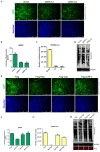Canine Circovirus Suppresses the Type I Interferon Response and Protein Expression but Promotes CPV-2 Replication
- PMID: 35742826
- PMCID: PMC9224199
- DOI: 10.3390/ijms23126382
Canine Circovirus Suppresses the Type I Interferon Response and Protein Expression but Promotes CPV-2 Replication
Abstract
Canine circovirus (CanineCV) is an emerging virus in canines. Since the first strain of CanineCV was reported in 2012, CanineCV infection has shown a trend toward becoming a global epidemic. CanineCV infection often occurs with coinfection with other pathogens that may aggravate the symptoms of disease in affected dogs. Currently, CanineCV has not been successfully isolated by laboratories, resulting in a lack of clarity regarding its physicochemical properties, replication process, and pathogenic characteristics. To address this knowledge gap, the following results were obtained in this study. First, a CanineCV strain was rescued in F81 cells using infectious clone plasmids. Second, the Rep protein produced by the viral packaging rescue process was found to be associated with cytopathic effects. Additionally, the Rep protein and CanineCV inhibited the activation of the type I interferon (IFN-I) promoter, blocking subsequent expression of interferon-stimulated genes (ISGs). Furthermore, Rep was found to broadly inhibit host protein expression. We speculate that in CanineCV and canine parvovirus type 2 (CPV-2) coinfection cases, CanineCV promotes CPV-2 replication by inducing immunosuppression, which may increase the severity of clinical symptoms.
Keywords: canine circovirus; canine parvovirus; coinfection; interferon response; protein expression inhibition.
Conflict of interest statement
The authors declare no conflict of interest.
Figures






Similar articles
-
Canine circovirus and Canine adenovirus type 1 and 2 in dogs with parvoviral enteritis.Vet Res Commun. 2022 Feb;46(1):223-232. doi: 10.1007/s11259-021-09850-y. Epub 2021 Oct 20. Vet Res Commun. 2022. PMID: 34671910 Free PMC article.
-
Role of canine circovirus in dogs with acute haemorrhagic diarrhoea.Vet Rec. 2017 Jun 3;180(22):542. doi: 10.1136/vr.103926. Epub 2017 Feb 27. Vet Rec. 2017. PMID: 28242782
-
Detection of canine circovirus in dogs infected with canine parvovirus.Acta Trop. 2022 Nov;235:106646. doi: 10.1016/j.actatropica.2022.106646. Epub 2022 Aug 8. Acta Trop. 2022. PMID: 35952924
-
Canine circovirus: An emerging or an endemic undiagnosed enteritis virus?Front Vet Sci. 2023 Apr 17;10:1150636. doi: 10.3389/fvets.2023.1150636. eCollection 2023. Front Vet Sci. 2023. PMID: 37138920 Free PMC article. Review.
-
Canine circovirus: an emerging virus of dogs and wild canids.Ir Vet J. 2025 Feb 8;78(1):5. doi: 10.1186/s13620-025-00290-7. Ir Vet J. 2025. PMID: 39920855 Free PMC article. Review.
Cited by
-
Epidemiological and evolutionary analysis of canine circovirus from 1996 to 2023.BMC Vet Res. 2024 Jul 20;20(1):328. doi: 10.1186/s12917-024-04186-6. BMC Vet Res. 2024. PMID: 39033103 Free PMC article.
-
Viral Co-Infection in Bats: A Systematic Review.Viruses. 2023 Aug 31;15(9):1860. doi: 10.3390/v15091860. Viruses. 2023. PMID: 37766267 Free PMC article.
-
Canine parvovirus NS1 induces host translation shutoff by reducing mTOR phosphorylation.J Virol. 2025 Jan 31;99(1):e0146324. doi: 10.1128/jvi.01463-24. Epub 2024 Nov 27. J Virol. 2025. PMID: 39601560 Free PMC article.
-
IFNAR(-/-) Mice Constitute a Suitable Animal Model for Epizootic Hemorrhagic Disease Virus Study and Vaccine Evaluation.Int J Biol Sci. 2024 May 27;20(8):3076-3093. doi: 10.7150/ijbs.95275. eCollection 2024. Int J Biol Sci. 2024. PMID: 38904031 Free PMC article.
-
Viral Coinfections.Viruses. 2022 Nov 26;14(12):2645. doi: 10.3390/v14122645. Viruses. 2022. PMID: 36560647 Free PMC article. Review.
References
MeSH terms
Substances
Grants and funding
LinkOut - more resources
Full Text Sources
Miscellaneous

